iOS 热更新解读(二)—— JSPatch 源码解析
关于 JSPatch 的实现原理,JSPatch 作者本人 bang 已经有一系列文章阐述: - JSPatch 实现原理详解 <一> 核心 - JSPatch 实现原理详解 <二> 细节 - JSPatch 实现原理详解 <三> 扩展 - JSPatch 实现原理详解 <四> 新特性 - JSPatch 实现原理详解 <五> 优化
这些文章是对 JSPatch 内部实现原理和细节诸如“require实现”、“property实现”、“self/super 关键字”、“nil处理”、“内存问题”等具体设计思路和解决方案的阐述,并没有对 JSPatch 源码进行解读。在未接触源码、不清楚整个热修复流程的情况下去读这几篇文章难免一头雾水,最好的方法是边读源码边对照上述文章,代码中不理解的地方可以去文章中寻找答案。 本文将从一个小demo入手,跟踪代码执行流程,从Cocoa层、JavaScript层、Native层对热修复流程中涉及到的重要步骤和函数进行解析。
JSPatch 使用流程
引入JSPatch,JSPatch 核心部分只有三个文件,十分精巧: 建立一个小demo,在 ViewController 屏幕中央放置一个button,button 点击事件为空:
// in ViewController.m -----------------
- (IBAction)handle:(id)sender {
}
热修复js文件(main.js)内容就是添加这个点击事件(弹出一个 AlertView ):
// in main.js ------------------------
defineClass('ViewController', {
handle: function(sender) {
require('UIAlertView');
var alert = UIAlertView.alloc().initWithTitle_message_delegate_cancelButtonTitle_otherButtonTitles("alert", null, null, "ok", null, null);
alert.show();
}
})
js 文件编写方法查看 JSPatch 基础用法 。
didFinishLaunchingWithOptions: 中开启 JSPatch 引擎、执行 js 脚本:
- (BOOL)application:(UIApplication *)application didFinishLaunchingWithOptions:(NSDictionary *)launchOptions {
// 开启 JPEngine.
[JPEngine startEngine];
NSString *sourcePath = [[NSBundle mainBundle] pathForResource:@"main" ofType:@"js"];
NSString *script = [NSString stringWithContentsOfFile:sourcePath encoding:NSUTF8StringEncoding error:nil];
// 执行js脚本代码.
[JPEngine evaluateScript:script];
return YES;
}
修复成功! 
修复 step 1:startEngine
[JPEngine startEngine];
该方法向 JSContext 环境注册了一系列供js调用oc方法的block,这些 block 内部大多是 调用 runtime 相关接口的 static 函数。最终读取 JSPatch.js 中的代码到 JSContext 环境,使得 main.js 可以调用 JSPatch.js 中定义的方法。 调用关系大致如下:
main.js ---> JSPatch.js ---> OC Block ---> runtime
源码解读:
+ (void)startEngine
{
// 1.判断是否存在 JSContext 类. ---> iOS 7.0 以下不支持 JavaScriptCore
if (![JSContext class] || _context) {
return;
}
// 2.创建一个 JS 运行环境.
JSContext *context = [[JSContext alloc] init];
// 3.为了使 JSPatch.js 可以访问 JPEngine 中定义的 C 函数,需为 context 注册 block.
// 3.1 创建类.
context[@"_OC_defineClass"] = ^(NSString *classDeclaration, JSValue *instanceMethods, JSValue *classMethods) {
return defineClass(classDeclaration, instanceMethods, classMethods);
};
// 3.2 给类实现某协议.
context[@"_OC_defineProtocol"] = ^(NSString *protocolDeclaration, JSValue *instProtocol, JSValue *clsProtocol) {
return defineProtocol(protocolDeclaration, instProtocol,clsProtocol);
};
// 3.3 js调用oc的实例方法.
context[@"_OC_callI"] = ^id(JSValue *obj, NSString *selectorName, JSValue *arguments, BOOL isSuper) {
return callSelector(nil, selectorName, arguments, obj, isSuper);
};
// 3.4 js调用oc的类方法.
context[@"_OC_callC"] = ^id(NSString *className, NSString *selectorName, JSValue *arguments) {
return callSelector(className, selectorName, arguments, nil, NO);
};
// 3.5 js 对象转 oc 对象.
context[@"_OC_formatJSToOC"] = ^id(JSValue *obj) {
return formatJSToOC(obj);
};
// 3.6 oc 对象 转 js 对象.
context[@"_OC_formatOCToJS"] = ^id(JSValue *obj) {
return formatOCToJS([obj toObject]);
};
// 3.7 获取对象的动态成员变量.
context[@"_OC_getCustomProps"] = ^id(JSValue *obj) {
id realObj = formatJSToOC(obj);
return objc_getAssociatedObject(realObj, kPropAssociatedObjectKey);
};
// 3.8 给对象动态添加成员变量.
context[@"_OC_setCustomProps"] = ^(JSValue *obj, JSValue *val) {
id realObj = formatJSToOC(obj);
objc_setAssociatedObject(realObj, kPropAssociatedObjectKey, val, OBJC_ASSOCIATION_RETAIN_NONATOMIC);
};
// 3.9 给 js 对象设置 weak.
context[@"__weak"] = ^id(JSValue *jsval) {
id obj = formatJSToOC(jsval);
return [[JSContext currentContext][@"_formatOCToJS"] callWithArguments:@[formatOCToJS([JPBoxing boxWeakObj:obj])]];
};
// 3.10 给 js 对象设置 strong.
context[@"__strong"] = ^id(JSValue *jsval) {
id obj = formatJSToOC(jsval);
return [[JSContext currentContext][@"_formatOCToJS"] callWithArguments:@[formatOCToJS(obj)]];
};
// 3.11 获取 oc 对象超类.
context[@"_OC_superClsName"] = ^(NSString *clsName) {
Class cls = NSClassFromString(clsName);
return NSStringFromClass([cls superclass]);
};
// 3.12 是否自动转换类型.
context[@"autoConvertOCType"] = ^(BOOL autoConvert) {
_autoConvert = autoConvert;
};
// 3.13 oc number 转换为 string.
context[@"convertOCNumberToString"] = ^(BOOL convertOCNumberToString) {
_convertOCNumberToString = convertOCNumberToString;
};
// 3.14 在JS中调用include方法,可以在一个JS文件中加载其他JS文件.
context[@"include"] = ^(NSString *filePath) {
NSString *absolutePath = [_scriptRootDir stringByAppendingPathComponent:filePath];
if (!_runnedScript) {
_runnedScript = [[NSMutableSet alloc] init];
}
if (absolutePath && ![_runnedScript containsObject:absolutePath]) {
[JPEngine _evaluateScriptWithPath:absolutePath];
[_runnedScript addObject:absolutePath];
}
};
// 3.15 获取资源文件路径.
context[@"resourcePath"] = ^(NSString *filePath) {
return [_scriptRootDir stringByAppendingPathComponent:filePath];
};
// 3.16 让 js 方法延迟执行.
context[@"dispatch_after"] = ^(double time, JSValue *func) {
dispatch_after(dispatch_time(DISPATCH_TIME_NOW, (int64_t)(time * NSEC_PER_SEC)), dispatch_get_main_queue(), ^{
[func callWithArguments:nil];
});
};
// 3.17 让js方法在 main queue dispatch async 执行.
context[@"dispatch_async_main"] = ^(JSValue *func) {
dispatch_async(dispatch_get_main_queue(), ^{
[func callWithArguments:nil];
});
};
// 3.18 让js方法在 main queue dispatch sync 执行.
context[@"dispatch_sync_main"] = ^(JSValue *func) {
if ([NSThread currentThread].isMainThread) {
[func callWithArguments:nil];
} else {
dispatch_sync(dispatch_get_main_queue(), ^{
[func callWithArguments:nil];
});
}
};
// 3.19 让js方法在 global queue dispatch async 执行.
context[@"dispatch_async_global_queue"] = ^(JSValue *func) {
dispatch_async(dispatch_get_global_queue(0, 0), ^{
[func callWithArguments:nil];
});
};
// 3.20 释放js创建的oc对象.
context[@"releaseTmpObj"] = ^void(JSValue *jsVal) {
if ([[jsVal toObject] isKindOfClass:[NSDictionary class]]) {
void *pointer = [(JPBoxing *)([jsVal toObject][@"__obj"]) unboxPointer];
id obj = *((__unsafe_unretained id *)pointer);
@synchronized(_TMPMemoryPool) {
[_TMPMemoryPool removeObjectForKey:[NSNumber numberWithInteger:[(NSObject*)obj hash]]];
}
}
};
// 3.21 js调用oc方法进行打印.
context[@"_OC_log"] = ^() {
NSArray *args = [JSContext currentArguments];
for (JSValue *jsVal in args) {
id obj = formatJSToOC(jsVal);
NSLog(@"JSPatch.log: %@", obj == _nilObj ? nil : (obj == _nullObj ? [NSNull null]: obj));
}
};
// 3.22 将js捕捉到的异常交给oc方法处理.
context[@"_OC_catch"] = ^(JSValue *msg, JSValue *stack) {
_exceptionBlock([NSString stringWithFormat:@"js exception, /nmsg: %@, /nstack: /n %@", [msg toObject], [stack toObject]]);
};
// 4. 注册 JSContext 执行出现异常时的回调.
context.exceptionHandler = ^(JSContext *con, JSValue *exception) {
NSLog(@"%@", exception);
_exceptionBlock([NSString stringWithFormat:@"js exception: %@", exception]);
};
// 5. 创建OC中的null对象,转换成js的null对象,并设置到JSContext实例让js代码可以获取.
_nullObj = [[NSObject alloc] init];
context[@"_OC_null"] = formatOCToJS(_nullObj);
// 6. 保存 context.
_context = context;
// 7. oc 中的 nil 对象.
_nilObj = [[NSObject alloc] init];
// 8. 同步锁.
_JSMethodSignatureLock = [[NSLock alloc] init];
_JSMethodForwardCallLock = [[NSRecursiveLock alloc] init];
// 9. 在 JSPatch 中注册过的结构体定义(键:结构体名).
_registeredStruct = [[NSMutableDictionary alloc] init];
// 10. 注册内存警告通知.
#if TARGET_OS_IPHONE
[[NSNotificationCenter defaultCenter] addObserver:self selector:@selector(handleMemoryWarning) name:UIApplicationDidReceiveMemoryWarningNotification object:nil];
#endif
// 11. 读取JSPatch.js,方便传入的js代码中使用JSPatch.js提供的函数.
NSString *path = [[NSBundle bundleForClass:[self class]] pathForResource:@"JSPatch" ofType:@"js"];
if (!path) _exceptionBlock(@"can't find JSPatch.js");
NSString *jsCore = [[NSString alloc] initWithData:[[NSFileManager defaultManager] contentsAtPath:path] encoding:NSUTF8StringEncoding];
// 12. 加载 JSPatch.js 中的所有 js 代码到JSContext.
if ([_context respondsToSelector:@selector(evaluateScript:withSourceURL:)]) {
[_context evaluateScript:jsCore withSourceURL:[NSURL URLWithString:@"JSPatch.js"]];
} else {
[_context evaluateScript:jsCore];
}
}
一张图总结 JSPatch 的功能结构: 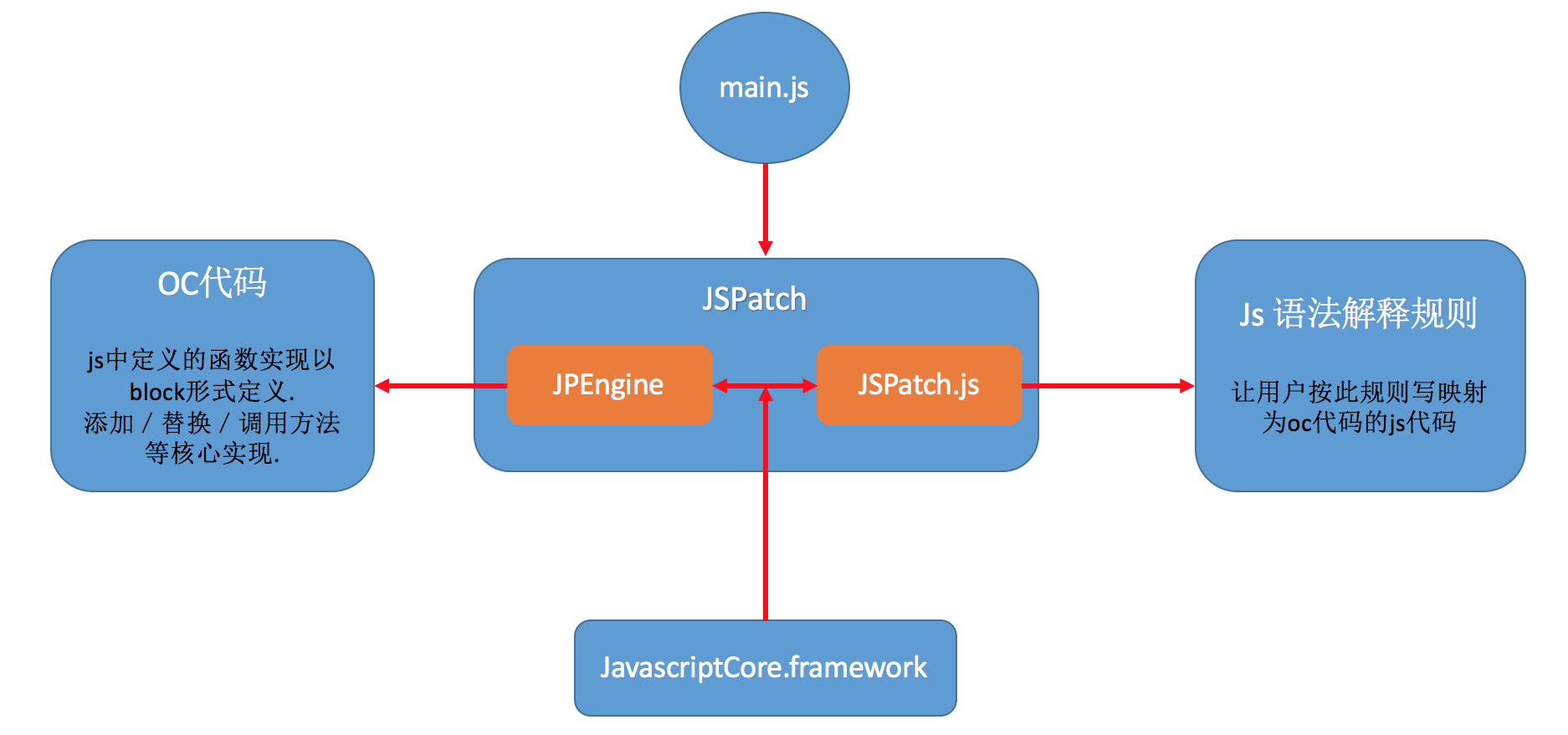
修复 step 2:__c()元函数
接下来读取 main.js 代码后执行:
[JPEngine evaluateScript:script];
该接口并非直接将 main.js 代码提交到 JSContext 环境执行,而是先调用 _evaluateScript: withSourceURL: 方法对 main.js 原始代码做些修改。 源码解读:
+ (JSValue *)_evaluateScript:(NSString *)script withSourceURL:(NSURL *)resourceURL
{
// 1. script 不存在或当前 iOS 版本低于 7.0 退出.
if (!script || ![JSContext class]) {
_exceptionBlock(@"script is nil");
return nil;
}
[self startEngine];
// 2. 正则式构建 (?<!////)//.//s*(//w+)//s*//(
if (!_regex) {
_regex = [NSRegularExpression regularExpressionWithPattern:_regexStr options:0 error:nil];
}
// 3. 使用正则式处理 传入的 js代码 >>> 将 alloc()这样的函数调用 替换成 __c("alloc")()
NSString *formatedScript = [NSString stringWithFormat:@";(function(){try{%@}catch(e){_OC_catch(e.message, e.stack)}})();", [_regex stringByReplacingMatchesInString:script options:0 range:NSMakeRange(0, script.length) withTemplate:_replaceStr]];
// 4.将正则处理后的js代码加载到 context 执行.(进入 JavaScriptCore)
@try {
if ([_context respondsToSelector:@selector(evaluateScript:withSourceURL:)]) {
return [_context evaluateScript:formatedScript withSourceURL:resourceURL];
} else {
return [_context evaluateScript:formatedScript];
}
}
@catch (NSException *exception) {
_exceptionBlock([NSString stringWithFormat:@"%@", exception]);
}
return nil;
}
断点调试看一下 script 经正则处理之后的结果:
;(function(){try{defineClass('ViewController', {
pushAlertView: function(sender) {
require('UIAlertView');
var alert = UIAlertView.__c("alloc")().__c("initWithTitle_message_delegate_cancelButtonTitle_otherButtonTitles")("alert", null, null, "ok", null, null);
alert.__c("show")();
}
})}catch(e){_OC_catch(e.message, e.stack)}})();
除了添加一些关键字和异常处理外,最大的变化在于所有函数调用变成了 __c("function") 的形式。据作者讲这是 JSPatch 开发过程中最核心的问题,该问题的解决方案也是 JSPatch 中最精妙之处。 我们进行热修复期望的效果是这样: 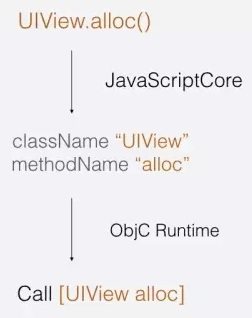 但JS 对于调用没定义的属性/变量,只会马上抛出异常,而不像 OC/Lua/ruby 那样有转发机制。因此对于用户传入的js代码中,类似
但JS 对于调用没定义的属性/变量,只会马上抛出异常,而不像 OC/Lua/ruby 那样有转发机制。因此对于用户传入的js代码中,类似 UIView().alloc().init() 这样的代码,js其实根本没办法进行处理。  一种解决方案是实现所有js类继承机制,每一个类和方法都事先定义好:
一种解决方案是实现所有js类继承机制,每一个类和方法都事先定义好:  这种方案是不太现实的,为了调用某个方法需要把该类的所有方法都引进来,占用内存极高(
这种方案是不太现实的,为了调用某个方法需要把该类的所有方法都引进来,占用内存极高( NSObject 类有将近1000个方法)。
作者最终想出了第二种方案:
在 OC 执行 JS 脚本前,通过正则把所有方法调用都改成调用 __c() 函数,再执行这个 JS 脚本,做到了类似 OC/Lua/Ruby 等的消息转发机制。
UIView.alloc().init()
->
UIView.__c('alloc')().__c('init')()
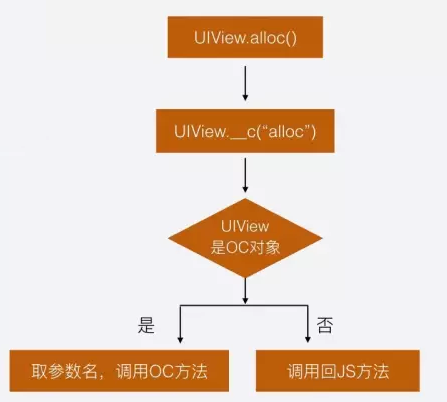 给 JS 对象基类 Object 的
给 JS 对象基类 Object 的 prototype 加上 c 成员,这样所有对象都可以调用到 c,根据当前对象类型判断进行不同操作:
__c: function(methodName) {
...
...
return function(){
var args = Array.prototype.slice.call(arguments)
return _methodFunc(slf.__obj, slf.__clsName, methodName, args, slf.__isSuper)
}
}
_methodFunc() 把相关信息传给OC,OC用 Runtime 接口调用相应方法,返回结果值,这个调用就结束了。 源码解读:
/**
* instance: 对象
* clsName: 类名
* methodName: 方法名
* args: 参数列表
* isSuper: 是否调用super父类的方法
* isPerformSelector:是否用performSelector方式调用
*/
var _methodFunc = function(instance, clsName, methodName, args, isSuper, isPerformSelector) {
var selectorName = methodName
if (!isPerformSelector) {
// 不是 performSelector方式的方法调用流程
// 处理得到OC中的方法SEL
methodName = methodName.replace(/__/g, "-")
selectorName = methodName.replace(/_/g, ":").replace(/-/g, "_")
var marchArr = selectorName.match(/:/g)
var numOfArgs = marchArr ? marchArr.length : 0
if (args.length > numOfArgs) {
selectorName += ":"
}
}
// 获取调用OC方法后的返回值
// 如果是获取一个OC对象,那么ret = {"__obj":OC对象},因为OC把对象返回给js之前会先包装成NSDictionary
var ret = instance ? _OC_callI(instance, selectorName, args, isSuper):
_OC_callC(clsName, selectorName, args)
// 获取OC方法执行完毕的返回值,并转化成JS对象
return _formatOCToJS(ret)
}
修复 step 3:global.defineClass
原脚本代码经过正则处理后交由 JSContext 环境去执行:
[_context evaluateScript:formatedScript withSourceURL:resourceURL];
回过头看 main.js 的代码(处理后的):
defineClass(`ViewController`,{instaceMethods...},{classMethods...})
参数依次为类名、实例方法列表、类方法列表。阅读 global.defineClass 源码会发现 defineClass 首先会分别对两个方法列表调用 _formatDefineMethods ,该方法参数有三个:方法列表(js对象)、空js对象、真实类名:
var _formatDefineMethods = function(methods, newMethods, realClsName) {
for (var methodName in methods) {
if (!(methods[methodName] instanceof Function)) return;
(function(){
var originMethod = methods[methodName]
newMethods[methodName] = [originMethod.length, function() {
try {
var args = _formatOCToJS(Array.prototype.slice.call(arguments))
var lastSelf = global.self
global.self = args[0]
if (global.self) global.self.__realClsName = realClsName
args.splice(0,1)
var ret = originMethod.apply(originMethod, args)
global.self = lastSelf
return ret
} catch(e) {
_OC_catch(e.message, e.stack)
}
}]
})()
}
}
该段代码遍历方法列表对象的方法名,向js空对象中添加属性:方法名为键,一个数组为值。数组第一个元素为对应实现函数的参数个数,第二个元素是方法的具体实现。也就是说, _formatDefineMethods 将 defineClass 传递过来的js对象进行了修改:
{
methodName:function(args...){...}
}
-->
{
methodName:[argCount,function(args...){...新实现}]
}
1. 为什么要传递参数个数? 因为 runtime 修复类的时候无法直接解析js实现函数,也就无法知道参数个数,但方法替换的过程需要生成方法签名,所以只能从js端拿到js函数的参数个数,并传递给OC。
2. 为什么要修改方法实现? - 参数转化为js对象。这涉及到对象生命周期的管理,具体查看 <实现原理一> 4.对象持有/转换。 - self 处理。使得js修复代码中我们可以像在 OC 中一样使用self,具体查看 <实现原理一> 6.self 关键字。 - args.splice(0,1) 删除前两个参数: OC中进行消息转发,前两个参数是 self 和 selector ,实际调用js的具体实现的时候,需要把这两个参数删除。
我们可以使用 safari 对 JSPatch.js 进行调试( JS 断点调试 )看看处理之后的 newInstMethods : 
回到 defineClass ,调用 _formatDefineMethods 之后,拿着要重写的类名和经过处理的js对象,调用 _OC_defineClass ,也就是OC端定义的block方法。
修复 step 4: OC defineClass
JPEngine 中的 defineClass 对类进行真正的重写操作,将类名、 selector 、方法实现(IMP)、方法签名等 runtime 重写方法所需的基本元素提取出来。 源码解读:
/**
* 定义一个类/覆盖或新增一个方法.
*
* @param classDeclaration 类的声明(需要替换或者新增的类名:继承的父类名 <实现的协议1,实现的协议2>)
* @param instanceMethods {实例方法}
* @param classMethods {类方法}
*
* @return 返回@{@"cls": className, @"superCls": superClassName}
*/
static NSDictionary *defineClass(NSString *classDeclaration, JSValue *instanceMethods, JSValue *classMethods)
{
// 1.使用 NSScanner 分离 classDeclaration.
NSScanner *scanner = [NSScanner scannerWithString:classDeclaration];
NSString *className; //类名
NSString *superClassName; //父类名
NSString *protocolNames; //实现的协议名
[scanner scanUpToString:@":" intoString:&className];
if (!scanner.isAtEnd) {
scanner.scanLocation = scanner.scanLocation + 1;
[scanner scanUpToString:@"<" intoString:&superClassName];
if (!scanner.isAtEnd) {
scanner.scanLocation = scanner.scanLocation + 1;
[scanner scanUpToString:@">" intoString:&protocolNames];
}
}
if (!superClassName) superClassName = @"NSObject";
className = trim(className);
superClassName = trim(superClassName);
NSArray *protocols = [protocolNames length] ? [protocolNames componentsSeparatedByString:@","] : nil;
// 2.获取该Class对象.
Class cls = NSClassFromString(className);
if (!cls) {
Class superCls = NSClassFromString(superClassName);
if (!superCls) {
_exceptionBlock([NSString stringWithFormat:@"can't find the super class %@", superClassName]);
return @{@"cls": className};
}
// 2.1 该Class对象为nil,为JS端添加一个新的类.
cls = objc_allocateClassPair(superCls, className.UTF8String, 0);
objc_registerClassPair(cls);
}
if (protocols.count > 0) {
for (NSString* protocolName in protocols) {
Protocol *protocol = objc_getProtocol([trim(protocolName) cStringUsingEncoding:NSUTF8StringEncoding]);
class_addProtocol (cls, protocol);
}
}
for (int i = 0; i < 2; i ++) {
BOOL isInstance = i == 0;
JSValue *jsMethods = isInstance ? instanceMethods: classMethods;
// 3.若是添加实例方法,直接使用Class对象;
// 若是添加类方法,需要获取元类.
Class currCls = isInstance ? cls: objc_getMetaClass(className.UTF8String);
// 把js对象转换成OC的字典,从而可以取到方法名、参数个数、具体实现.
NSDictionary *methodDict = [jsMethods toDictionary];
for (NSString *jsMethodName in methodDict.allKeys) {
// 遍历字典的key,即方法名,根据方法名取出的值还是JSValue对象,它代表的是数组,第一个值是参数的个数,第二个值是函数的实现.
JSValue *jsMethodArr = [jsMethods valueForProperty:jsMethodName];
int numberOfArg = [jsMethodArr[0] toInt32];
NSString *selectorName = convertJPSelectorString(jsMethodName);
if ([selectorName componentsSeparatedByString:@":"].count - 1 < numberOfArg) {
selectorName = [selectorName stringByAppendingString:@":"];
}
JSValue *jsMethod = jsMethodArr[1];
if (class_respondsToSelector(currCls, NSSelectorFromString(selectorName))) {
// 4.如果要替换的类已经定义了该方法,直接对该方法替换和实现消息转发.
overrideMethod(currCls, selectorName, jsMethod, !isInstance, NULL);
} else {
BOOL overrided = NO;
for (NSString *protocolName in protocols) {
// 5.1 遍历protocolsNames,依次获取协议对象和协议方法中的type和name
char *types = methodTypesInProtocol(protocolName, selectorName, isInstance, YES);
if (!types) types = methodTypesInProtocol(protocolName, selectorName, isInstance, NO);
if (types) {
// 对协议方法实现消息转发.
overrideMethod(currCls, selectorName, jsMethod, !isInstance, types);
free(types);
overrided = YES;
break;
}
}
if (!overrided) {
// 5.2 上述两种情况都不满足.js端请求添加一个新的方法.
if (![[jsMethodName substringToIndex:1] isEqualToString:@"_"]) {
// 方法名的处理:_改为:
NSMutableString *typeDescStr = [@"@@:" mutableCopy];
for (int i = 0; i < numberOfArg; i ++) {
[typeDescStr appendString:@"@"];
}
// 构造一个typeDescription为"@@:/@*"的IMP.将这个IMP添加到类中.
overrideMethod(currCls, selectorName, jsMethod, !isInstance, [typeDescStr cStringUsingEncoding:NSUTF8StringEncoding]);
}
}
}
}
}
// 6.为该类添加两个方法,使js脚本拥有设置property的方法.
#pragma clang diagnostic push
#pragma clang diagnostic ignored "-Wundeclared-selector"
class_addMethod(cls, @selector(getProp:), (IMP)getPropIMP, "@@:@");
class_addMethod(cls, @selector(setProp:forKey:), (IMP)setPropIMP, "v@:@@");
#pragma clang diagnostic pop
// 7.返回字典给js脚本
return @{@"cls": className, @"superCls": superClassName};
}
由源码可见,方法名、实现等处理好之后最终执行 overrideMethod 方法。
修复 step 5:overrideMethod
overrideMethod 是实现 “替换” 的最后一步。通过调用一系列runtime 方法增加/替换实现的api,使用 jsvalue 中将要替换的方法实现来替换oc类中的方法实现。 该函数做的事情比较多,一张图概括如下: 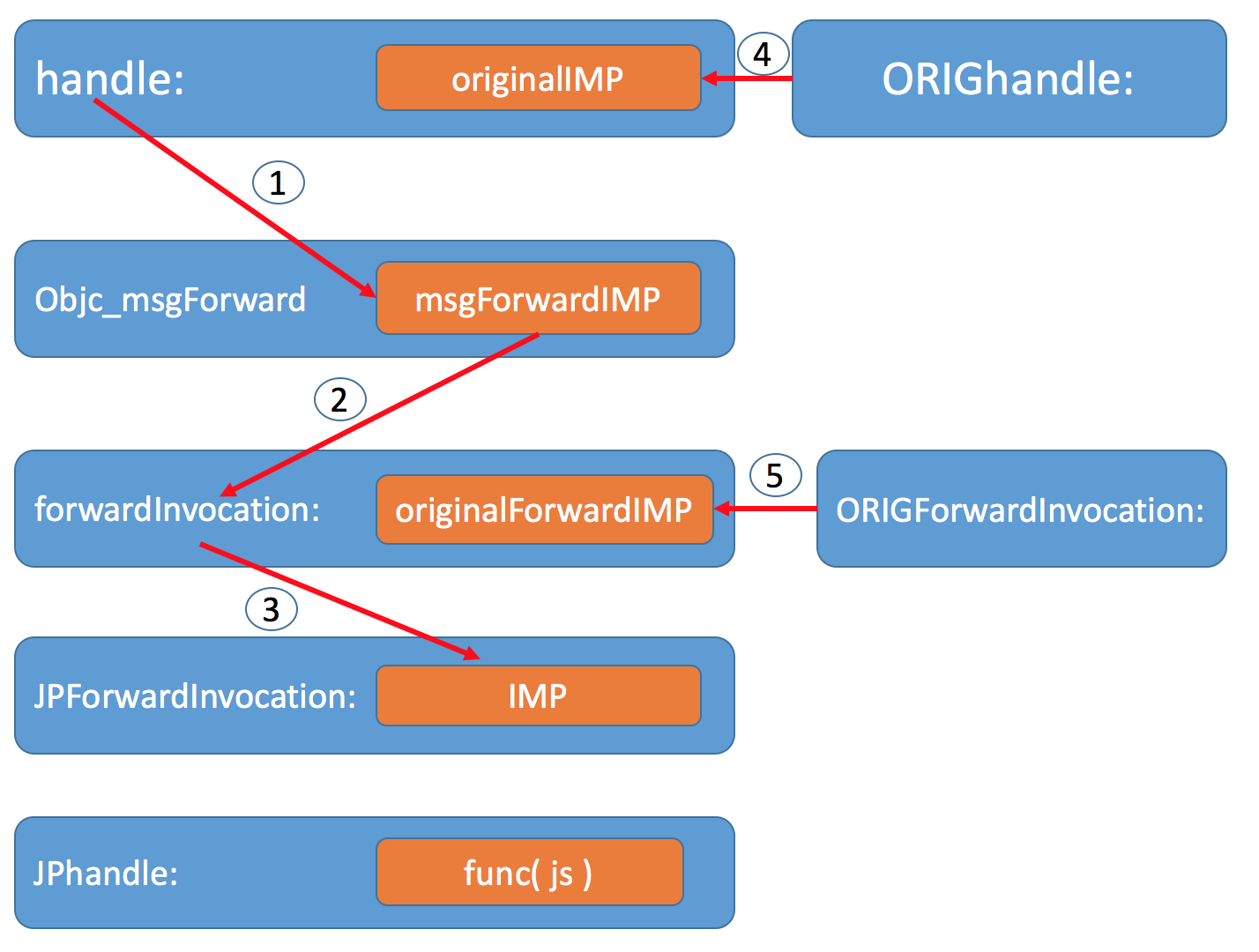 4.向class添加名为ORIG+selector,对应原始selector的IMP。 这一步是为了让js通过这个方法调用原来的实现。
4.向class添加名为ORIG+selector,对应原始selector的IMP。 这一步是为了让js通过这个方法调用原来的实现。
5.向class添加名为 ORIGforwardInvocation 的方法,实现是原始的 forwardInvocation 的IMP。 这一步是为了保存 forwardInvocation 的旧有实现,在新的实现中做判断,如果转发的方法是欲改写的,就走新逻辑,反之走原来的流程。 源码解读:
/**
* 使用jsvalue中将要替换的方法实现来替换oc类中的方法实现
*
* @param cls 被替换的类
* @param selectorName 被替换实现的SEL
* @param function 在js中定义的将要替换的新的实现
* @param isClassMethod 是否类方法(如果是-->寻找MetaClass)
* @param typeDescription 被替换的实现方法的编码
*/
static void overrideMethod(Class cls, NSString *selectorName, JSValue *function, BOOL isClassMethod, const char *typeDescription)
{
// 1. 要重写的方法的SEL.
SEL selector = NSSelectorFromString(selectorName);
// 2. 获取重写方法的具体实现函数的格式编码.
if (!typeDescription) {
Method method = class_getInstanceMethod(cls, selector);
typeDescription = (char *)method_getTypeEncoding(method);
}
// 3.获取 class 中被重写 SEL 对应的原始IMP.
IMP originalImp = class_respondsToSelector(cls, selector) ? class_getMethodImplementation(cls, selector) : NULL;
// 4.准备进入消息转发处理的系统函数实现IMP.
IMP msgForwardIMP = _objc_msgForward;
// 5.针对“非 arm64”架构,消息转发应使用 _objc_msgForward_stret 系统函数.
// 因为_objc_msgForward函数在cpu架构不是 arm64 时,处理返回值是一些特殊 struct 时可能造成 crash.
#if !defined(__arm64__)
if (typeDescription[0] == '{') {
//In some cases that returns struct, we should use the '_stret' API:
//http://sealiesoftware.com/blog/archive/2008/10/30/objc_explain_objc_msgSend_stret.html
//NSMethodSignature knows the detail but has no API to return, we can only get the info from debugDescription.
NSMethodSignature *methodSignature = [NSMethodSignature signatureWithObjCTypes:typeDescription];
if ([methodSignature.debugDescription rangeOfString:@"is special struct return? YES"].location != NSNotFound) {
msgForwardIMP = (IMP)_objc_msgForward_stret;
}
}
#endif
#pragma clang diagnostic push
#pragma clang diagnostic ignored "-Wundeclared-selector"
if (class_getMethodImplementation(cls, @selector(forwardInvocation:)) != (IMP)JPForwardInvocation) {
// 6.将cls中原来 forwardInvocaiton: 的实现替换成 JPForwardInvocation:函数实现.
// class_replaceMethod()返回的是替换之前的 IMP.
IMP originalForwardImp = class_replaceMethod(cls, @selector(forwardInvocation:), (IMP)JPForwardInvocation, "v@:@");
if (originalForwardImp) {
// 7.为cls添加新的SEL(ORIGforwardInvocation:),指向原始 forwardInvocation: 的实现IMP.
class_addMethod(cls, @selector(ORIGforwardInvocation:), originalForwardImp, "v@:@");
}
}
#pragma clang diagnostic pop
[cls jp_fixMethodSignature];
if (class_respondsToSelector(cls, selector)) {
NSString *originalSelectorName = [NSString stringWithFormat:@"ORIG%@", selectorName];
SEL originalSelector = NSSelectorFromString(originalSelectorName);
if(!class_respondsToSelector(cls, originalSelector)) {
// 8.为cls添加新的SEL(ORIG...:)指向被替换方法的原始实现IMP.
class_addMethod(cls, originalSelector, originalImp, typeDescription);
}
}
// 9.构造替换实现后的新SEL:(JP...)
NSString *JPSelectorName = [NSString stringWithFormat:@"_JP%@", selectorName];
// 10.记录新SEL对应js传过来的待替换目标方法的实现.
_initJPOverideMethods(cls);
_JSOverideMethods[cls][JPSelectorName] = function;
// 11.替换原SEL的实现IMP为msgForwardIMP
// 让被替换的方法调用时,直接进入“消息转发”流程(_objc_msgForward 或 _objc_msgForward_stret)
// 这一步放到最后是为了避免在 overrideMethod 过程中调用原sel导致的线程问题.
class_replaceMethod(cls, selector, msgForwardIMP, typeDescription);
}
至此, selector 具体实现 IMP 的替换工作已经完成了。接下来便可以分析一下点击button后的 handle 事件。
调用 step 1:JPForwardInvocation
经过上一步处理, handle: 直接走 objc_msgForward 进行消息转发环节。当点击button,调用 handle: 的时候,函数调用的参数会被封装到 NSInvocation 对象,走到 forwardInvocation 方法。上一步中 forwardInvocation 方法的实现替换成了 JPForwardInvocation , 负责拦截系统消息转发函数传入的 NSInvocation 并从中获取到所有的方法执行参数值,是实现替换和新增方法的核心 。 源码解读:
/**
* 替换原有的forwarInvocation:方法
*
* @param assignSlf self
* @param selector 原始SEL
* @param invocation 封装了函数调用参数的NSInvocation对象
*/
static void JPForwardInvocation(__unsafe_unretained id assignSlf, SEL selector, NSInvocation *invocation)
{
// 1.表示oc对象是否已经被释放
BOOL deallocFlag = NO;
id slf = assignSlf;
// 2.获取invocation中参数的数量
NSMethodSignature *methodSignature = [invocation methodSignature];
NSInteger numberOfArguments = [methodSignature numberOfArguments];
// 3.转化调用的SEL为JPSEL(这是JSPatch中缓存JSValue* function的key格式)
NSString *selectorName = NSStringFromSelector(invocation.selector);
NSString *JPSelectorName = [NSString stringWithFormat:@"_JP%@", selectorName];
// 4.判断JPSEL是否有对应的js函数的实现,如果没有就走原始方法的消息转发的流程.
JSValue *jsFunc = getJSFunctionInObjectHierachy(slf, JPSelectorName);
if (!jsFunc) {
JPExecuteORIGForwardInvocation(slf, selector, invocation);
return;
}
// 5.从NSInvocation中获取调用的参数,把self与相应的参数都转换成js对象并封装到一个集合中
// js端重写的函数,传递过来是JSValue类型,用callWithArgument:调用js方法,参数也要是js对象.
// 5.1 初始化数组,存储NSInvacation中获取的参数列表,传给对应的js函数
NSMutableArray *argList = [[NSMutableArray alloc] init];
if ([slf class] == slf) {
// 5.2 类方法:设置__clsName标识表明这是一个类对象
[argList addObject:[JSValue valueWithObject:@{@"__clsName": NSStringFromClass([slf class])} inContext:_context]];
} else if ([selectorName isEqualToString:@"dealloc"]) {
// 5.3 要被释放的对象:使用assign来保存self指针
[argList addObject:[JPBoxing boxAssignObj:slf]];
deallocFlag = YES;
} else {
// 5.4 使用 weak 保存self 指针
[argList addObject:[JPBoxing boxWeakObj:slf]];
}
// 5.5 NSInvocation 对象的前两个参数是self和_cmd(http://stackoverflow.com/questions/5788346/calling-a-selector-with-unknown-number-of-arguments-using-reflection-introspec)
// 所以直接从第3个参数开始获取
for (NSUInteger i = 2; i < numberOfArguments; i++) {
const char *argumentType = [methodSignature getArgumentTypeAtIndex:i];
// 返回值如果是const,获取encoding来判断类型.
switch(argumentType[0] == 'r' ? argumentType[1] : argumentType[0]) {
// 从invocation中获取参数,添加到argList中.
#define JP_FWD_ARG_CASE(_typeChar, _type) /
case _typeChar: { /
_type arg; /
[invocation getArgument:&arg atIndex:i]; /
[argList addObject:@(arg)]; /
break; /
}
JP_FWD_ARG_CASE('c', char)
JP_FWD_ARG_CASE('C', unsigned char)
JP_FWD_ARG_CASE('s', short)
JP_FWD_ARG_CASE('S', unsigned short)
JP_FWD_ARG_CASE('i', int)
JP_FWD_ARG_CASE('I', unsigned int)
JP_FWD_ARG_CASE('l', long)
JP_FWD_ARG_CASE('L', unsigned long)
JP_FWD_ARG_CASE('q', long long)
JP_FWD_ARG_CASE('Q', unsigned long long)
JP_FWD_ARG_CASE('f', float)
JP_FWD_ARG_CASE('d', double)
JP_FWD_ARG_CASE('B', BOOL)
case '@': {
// id类型参数使用__unsafe__unretained
__unsafe_unretained id arg;
[invocation getArgument:&arg atIndex:i];
// block参数使用copy,_nilObj表示nil
if ([arg isKindOfClass:NSClassFromString(@"NSBlock")]) {
[argList addObject:(arg ? [arg copy]: _nilObj)];
} else {
[argList addObject:(arg ? arg: _nilObj)];
}
break;
}
case '{': {
// 处理结构体类型参数
// 获取结构体类型名称,把参数包装成JSValue类型
NSString *typeString = extractStructName([NSString stringWithUTF8String:argumentType]);
#define JP_FWD_ARG_STRUCT(_type, _transFunc) /
if ([typeString rangeOfString:@#_type].location != NSNotFound) { /
_type arg; /
[invocation getArgument:&arg atIndex:i]; /
[argList addObject:[JSValue _transFunc:arg inContext:_context]]; /
break; /
}
JP_FWD_ARG_STRUCT(CGRect, valueWithRect)
JP_FWD_ARG_STRUCT(CGPoint, valueWithPoint)
JP_FWD_ARG_STRUCT(CGSize, valueWithSize)
JP_FWD_ARG_STRUCT(NSRange, valueWithRange)
// 自定义类型的结构体处理
@synchronized (_context) {
NSDictionary *structDefine = _registeredStruct[typeString];
if (structDefine) {
size_t size = sizeOfStructTypes(structDefine[@"types"]);
if (size) {
void *ret = malloc(size);
[invocation getArgument:ret atIndex:i];
NSDictionary *dict = getDictOfStruct(ret, structDefine);
[argList addObject:[JSValue valueWithObject:dict inContext:_context]];
free(ret);
break;
}
}
}
break;
}
case ':': {
// selector类型处理
SEL selector;
[invocation getArgument:&selector atIndex:i];
NSString *selectorName = NSStringFromSelector(selector);
[argList addObject:(selectorName ? selectorName: _nilObj)];
break;
}
case '^':
case '*': {
// 指针类型处理
void *arg;
[invocation getArgument:&arg atIndex:i];
[argList addObject:[JPBoxing boxPointer:arg]];
break;
}
case '#': {
// Class类型
Class arg;
[invocation getArgument:&arg atIndex:i];
[argList addObject:[JPBoxing boxClass:arg]];
break;
}
default: {
NSLog(@"error type %s", argumentType);
break;
}
}
}
if (_currInvokeSuperClsName) {
Class cls = NSClassFromString(_currInvokeSuperClsName);
NSString *tmpSelectorName = [[selectorName stringByReplacingOccurrencesOfString:@"_JPSUPER_" withString:@"_JP"] stringByReplacingOccurrencesOfString:@"SUPER_" withString:@"_JP"];
if (!_JSOverideMethods[cls][tmpSelectorName]) {
NSString *ORIGSelectorName = [selectorName stringByReplacingOccurrencesOfString:@"SUPER_" withString:@"ORIG"];
[argList removeObjectAtIndex:0];
id retObj = callSelector(_currInvokeSuperClsName, ORIGSelectorName, [JSValue valueWithObject:argList inContext:_context], [JSValue valueWithObject:@{@"__obj": slf, @"__realClsName": @""} inContext:_context], NO);
id __autoreleasing ret = formatJSToOC([JSValue valueWithObject:retObj inContext:_context]);
[invocation setReturnValue:&ret];
return;
}
}
// 6.将上面获得的参数列表数组转化为对应的js对象数组
NSArray *params = _formatOCToJSList(argList);
char returnType[255];
// 7.获取返回值类型
strcpy(returnType, [methodSignature methodReturnType]);
// Restore the return type
if (strcmp(returnType, @encode(JPDouble)) == 0) {
strcpy(returnType, @encode(double));
}
if (strcmp(returnType, @encode(JPFloat)) == 0) {
strcpy(returnType, @encode(float));
}
// 7.1 返回值是否为const,如果是,获取后面的encoding来判断类型
switch (returnType[0] == 'r' ? returnType[1] : returnType[0]) {
...(返回值的其它封装规则,具体看源码)
}
if (_pointersToRelease) {
for (NSValue *val in _pointersToRelease) {
void *pointer = NULL;
[val getValue:&pointer];
CFRelease(pointer);
}
_pointersToRelease = nil;
}
// 8.待替换的方法是 delloc 需要特殊处理:
if (deallocFlag) {
slf = nil;
Class instClass = object_getClass(assignSlf);
Method deallocMethod = class_getInstanceMethod(instClass, NSSelectorFromString(@"ORIGdealloc"));
//获取原delloc imp 指针,调用delloc,防止内存泄漏.
void (*originalDealloc)(__unsafe_unretained id, SEL) = (__typeof__(originalDealloc))method_getImplementation(deallocMethod);
originalDealloc(assignSlf, NSSelectorFromString(@"dealloc"));
}
}
接下来执行JS中定义的方法实现。“修复 step 2”中已经讨论过,现在main.js中所有的函数都被替换成名为 __c('methodName') 的函数调用, __c 调用了 _methodFunc 函数, _methodFunc 会根据方法类型调用 _OC_call :
var ret = instance ? _OC_callI(instance, selectorName, args, isSuper):
_OC_callC(clsName, selectorName, args)
_OC_callI 或 _OC_callC 最终都会调用一个 static 函数 callSelector 。
调用 step 2:callSelector
main.js 中类似 UIAlertView.alloc().init() 实际是通过 callSelector 调用 OC 的方法。 - 将 js 对象和参数转化为 OC 对象; - 判断是否调用的是父类的方法,如果是,就走父类的方法实现; - 把参数等信息封装成NSInvocation对象,并执行,然后返回结果。
源码解读:
/**
* 完成oc中的方法调用
*
* @param className 类名(nil --> 表示实例方法)
* @param selectorName 方法SEL值
* @param arguments 方法执行参数
* @param instance 对象(js对象中的变量,如: var UIAlertView = { __clsName : 'UIAlertView'})
* @param isSuper 是否调用的是父类方法
*
* @return 方法执行后的结果值,返回给js代码中.
*/
static id callSelector(NSString *className, NSString *selectorName, JSValue *arguments, JSValue *instance, BOOL isSuper)
{
NSString *realClsName = [[instance valueForProperty:@"__realClsName"] toString];
if (instance) {
// 1.将js封装的instance对象进行拆装,得到oc对象.
instance = formatJSToOC(instance);
if (!instance || instance == _nilObj || [instance isKindOfClass:[JPBoxing class]]) return @{@"__isNil": @(YES)};
}
// 2.将js封装的参数列表转为oc类型.
id argumentsObj = formatJSToOC(arguments);
if (instance && [selectorName isEqualToString:@"toJS"]) {
// 3.如果要执行的方法是"toJS",即转化为js类型,对于NSString/NSDictory/NSArray/NSData需进行特殊处理
// 因为JSPatch中需使用JPBoxing包装OC中的上述对象,防止JavaScriptCore.framework转换类型.
if ([instance isKindOfClass:[NSString class]] || [instance isKindOfClass:[NSDictionary class]] || [instance isKindOfClass:[NSArray class]] || [instance isKindOfClass:[NSDate class]]) {
return _unboxOCObjectToJS(instance);
}
}
// 4.根据类名与selectorName获得对应的类对象与selector
Class cls = instance ? [instance class] : NSClassFromString(className);
SEL selector = NSSelectorFromString(selectorName);
NSString *superClassName = nil;
// 5.判断是否调用的是父类的方法,如果是,走父类的方法实现
if (isSuper) {
// 5.1 定义新的SEL:SUPERSEL
NSString *superSelectorName = [NSString stringWithFormat:@"SUPER_%@", selectorName];
SEL superSelector = NSSelectorFromString(superSelectorName);
Class superCls;
if (realClsName.length) {
Class defineClass = NSClassFromString(realClsName);
superCls = defineClass ? [defineClass superclass] : [cls superclass];
} else {
superCls = [cls superclass];
}
Method superMethod = class_getInstanceMethod(superCls, selector);
IMP superIMP = method_getImplementation(superMethod);
// 5.2 将SUPERSEL指向superIMP的实现
class_addMethod(cls, superSelector, superIMP, method_getTypeEncoding(superMethod));
// 5.3 查找父类中是否有添加JPSEL的实现
NSString *JPSelectorName = [NSString stringWithFormat:@"_JP%@", selectorName];
JSValue *overideFunction = _JSOverideMethods[superCls][JPSelectorName];
if (overideFunction) {
// 如果有,进行imp替换
overrideMethod(cls, superSelectorName, overideFunction, NO, NULL);
}
selector = superSelector;
superClassName = NSStringFromClass(superCls);
}
NSMutableArray *_markArray;
// 6.通过类对象与selector构造对应的NSMethodSignature签名
NSInvocation *invocation;
NSMethodSignature *methodSignature;
if (!_JSMethodSignatureCache) {
_JSMethodSignatureCache = [[NSMutableDictionary alloc]init];
}
if (instance) {
[_JSMethodSignatureLock lock];
if (!_JSMethodSignatureCache[cls]) {
_JSMethodSignatureCache[(id<NSCopying>)cls] = [[NSMutableDictionary alloc]init];
}
methodSignature = _JSMethodSignatureCache[cls][selectorName];
if (!methodSignature) {
methodSignature = [cls instanceMethodSignatureForSelector:selector];
methodSignature = fixSignature(methodSignature);
_JSMethodSignatureCache[cls][selectorName] = methodSignature;
}
[_JSMethodSignatureLock unlock];
if (!methodSignature) {
_exceptionBlock([NSString stringWithFormat:@"unrecognized selector %@ for instance %@", selectorName, instance]);
return nil;
}
// 7.根据签名构造NSInvocation对象
invocation = [NSInvocation invocationWithMethodSignature:methodSignature];
// 8.为invocation对象设置target
[invocation setTarget:instance];
} else {
methodSignature = [cls methodSignatureForSelector:selector];
methodSignature = fixSignature(methodSignature);
if (!methodSignature) {
_exceptionBlock([NSString stringWithFormat:@"unrecognized selector %@ for class %@", selectorName, className]);
return nil;
}
invocation= [NSInvocation invocationWithMethodSignature:methodSignature];
[invocation setTarget:cls];
}
// 9.为invocation对象设置selector
[invocation setSelector:selector];
// 10.根据签名得知每个参数的实际类型
NSUInteger numberOfArguments = methodSignature.numberOfArguments;
NSInteger inputArguments = [(NSArray *)argumentsObj count];
if (inputArguments > numberOfArguments - 2) {
// 10.1 多参数方法仅支持 id 类型参数和 id 类型返回,直接revoke并返回.
id sender = instance != nil ? instance : cls;
id result = invokeVariableParameterMethod(argumentsObj, methodSignature, sender, selector);
return formatOCToJS(result);
}
// 10.2 将JS传递过来的参数进行对应的转换(如 NSNumber -> int),转换后为 NSInvocation 对象设置参数.
for (NSUInteger i = 2; i < numberOfArguments; i++) {
const char *argumentType = [methodSignature getArgumentTypeAtIndex:i];
id valObj = argumentsObj[i-2];
switch (argumentType[0] == 'r' ? argumentType[1] : argumentType[0]) {
//...(具体转换规则看源代码)
}
}
if (superClassName) _currInvokeSuperClsName = superClassName;
// 11.执行 invoke 方法,并且传递指定的参数
[invocation invoke];
if (superClassName) _currInvokeSuperClsName = nil;
if ([_markArray count] > 0) {
for (JPBoxing *box in _markArray) {
void *pointer = [box unboxPointer];
id obj = *((__unsafe_unretained id *)pointer);
if (obj) {
@synchronized(_TMPMemoryPool) {
[_TMPMemoryPool setObject:obj forKey:[NSNumber numberWithInteger:[(NSObject*)obj hash]]];
}
}
}
}
char returnType[255];
strcpy(returnType, [methodSignature methodReturnType]);
// Restore the return type
if (strcmp(returnType, @encode(JPDouble)) == 0) {
strcpy(returnType, @encode(double));
}
if (strcmp(returnType, @encode(JPFloat)) == 0) {
strcpy(returnType, @encode(float));
}
id returnValue;
if (strncmp(returnType, "v", 1) != 0) {
if (strncmp(returnType, "@", 1) == 0) {
void *result;
// 12. 获取 invocation 运行返回值.
[invocation getReturnValue:&result];
// 13. 将返回值封装成JS对应的对象并返回.
//For performance, ignore the other methods prefix with alloc/new/copy/mutableCopy
if ([selectorName isEqualToString:@"alloc"] || [selectorName isEqualToString:@"new"] ||
[selectorName isEqualToString:@"copy"] || [selectorName isEqualToString:@"mutableCopy"]) {
returnValue = (__bridge_transfer id)result;
} else {
returnValue = (__bridge id)result;
}
return formatOCToJS(returnValue);
} else {
switch (returnType[0] == 'r' ? returnType[1] : returnType[0]) {
//...(具体转换规则见源代码)
return returnValue;
}
}
return nil;
}
至此,JSPatch 热修复核心步骤「方法替换」和「方法调用」就结束了。
总结
JSPatch 基于 JavaScriptCore.framework 和Objective-C中的runtime技术。
- 采用 iOS7 后引入的 JavaScriptCore.framework 作为 JavaScript 引擎解析js脚本,执行js代码并与OC端代码进行桥接。 - 使用Objective-C runtime 中的 method swizzling 方式达到使用js脚本动态替换原有OC方法的目的,并利用 forwardInvocation 消息转发机制使得在js脚本中调用OC的方法成为可能。
JSPatch 实现过程中还有许多细节问题诸如 Special Struct、内存管理、 JPBoxing 、 nil 处理等,更多详细内容可以阅读作者的原理详解系列文章以及 GitHub wiki 。学习 JSPatch 不仅可以弄清 iOS 热修复机制,也可以体会到如何利用 runtime 这一 OC 最重要的特性来实现一些强大的功能。这里不得不佩服作者深厚的编程功底和各种精彩的奇思妙想。
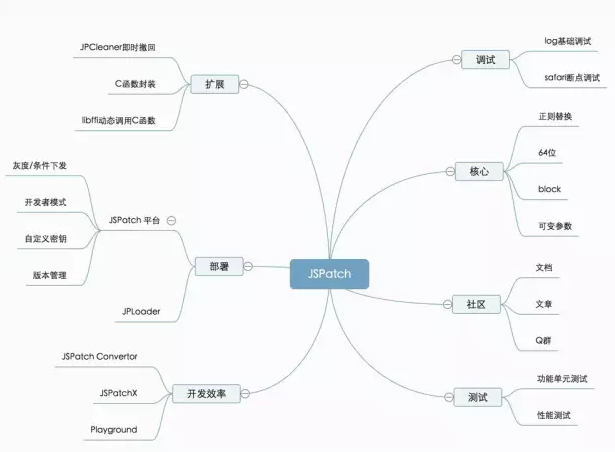
- 本文标签: 返回值类型 db 删除 线程 代码 Property key root 同步 js IDE IOS HTML 参数 cmd http description GitHub JavaScript 实例 java 总结 git 文章 调试 App cache REST tab core find API Atom Select 锁 struct ACE UI CTO ORM list 源码 src tar 管理 queue 遍历 开发 ip 生命 cat CEO Action value 协议 explain NSA message 解析
- 版权声明: 本文为互联网转载文章,出处已在文章中说明(部分除外)。如果侵权,请联系本站长删除,谢谢。
- 本文海报: 生成海报一 生成海报二











![[HBLOG]公众号](https://www.liuhaihua.cn/img/qrcode_gzh.jpg)

